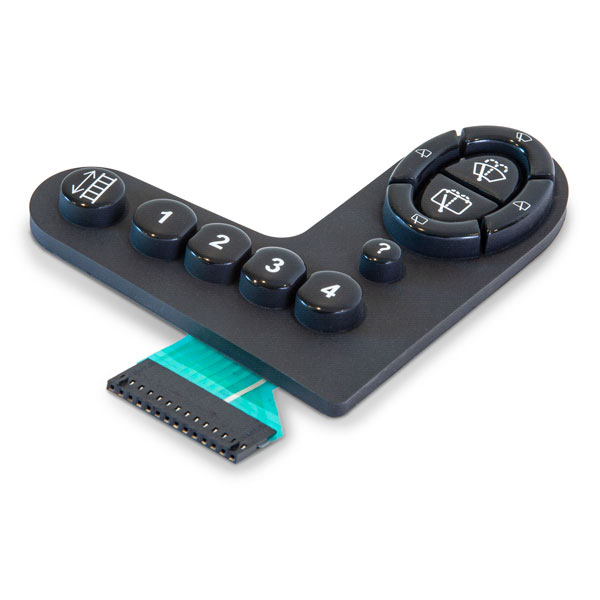How Membrane Switches Are Shaping the Future of Electronic Interfaces
Comprehending Membrane Layer Switches Over: The Key to Resilient and Reliable Controls
What Are Membrane Layer Switches?
Membrane switches are an advanced solution in the realm of interface technology, incorporating capability and design perfectly. These gadgets act as an interface between individuals and electronic systems, integrating a number of elements right into a small format. Normally created from adaptable, slim layers of materials, membrane switches are developed to reply to touch, allowing individuals to communicate with equipment and digital tools properly.
The key components of a membrane layer button include a published circuit layer, visuals overlay, and a spacer layer that protects against unplanned activation. The visuals overlay can be tailored to mirror brand name identification or customer choices, improving visual appeals while making certain use. Membrane layer buttons are frequently used in different applications, including clinical tools, consumer electronics, and industrial devices, owing to their durability and resistance to ecological variables such as dampness and dirt.
One of the key benefits of membrane switches is their capacity to hold up against deterioration, making them optimal for high-traffic atmospheres. In addition, they are lightweight and call for very little space, permitting for cutting-edge designs in product growth. In general, membrane changes represent a efficient and functional choice for modern-day electronic user interfaces, weding modern technology with user-centric style principles.
Just How Membrane Switches Over Work
The operation of membrane layer switches over hinges on a simple yet effective system that converts user input into electronic signals. When a customer presses the switch, the top layer warps, permitting a conductive element in the circuit layer to make contact with an equivalent conductive pad on the bottom of the visuals overlay.
The design of membrane layer switches can differ, but they frequently incorporate domes or tactile aspects to give comments to the customer, boosting the total experience - membrane switch. The products made use of in membrane layer switches, such as polyester or polycarbonate, add to their durability and resistance to environmental elements, including dampness and dirt. The printed circuits are typically encapsulated, which shields them from wear and tear over time.
Advantages of Membrane Buttons

Additionally, membrane layer buttons are understood for their toughness. Constructed from robust materials, they are immune to dirt, dampness, and physical wear, which significantly extends their life expectancy compared to standard mechanical buttons. This toughness makes them specifically ideal for high-traffic atmospheres and applications calling for long life.
An additional substantial advantage is the convenience of cleansing and upkeep. The smooth surface of membrane switches over decreases dirt buildup and is frequently unsusceptible spills, making them excellent for settings that call for constant sanitization.
Additionally, membrane layer switches offer a structured account, resulting in a thinner style that can be integrated into numerous tools without adding bulk. This attribute not just improves the aesthetic allure yet additionally adds to a much more ergonomic anonymous product layout.
Applications of Membrane Layer Switches
Versatile and straightforward, membrane buttons discover applications across a large range of industries, including clinical gadgets, consumer electronic devices, and industrial devices. In the medical area, these switches are integral to tools such as diagnostic tools, individual tracking systems, and infusion pumps, where integrity and simplicity of cleansing are essential. Their capability to endure severe settings and keep capability makes them suitable for such applications.

In customer electronics, membrane layer switches are utilized in items like microwaves, washing makers, and remote controls - membrane switch. Their smooth design permits instinctive user interfaces, improving the total customer experience while giving resilience and resistance to put on and tear
Industrial devices also takes advantage of membrane buttons, specifically in control panels for machinery and automation systems. These switches provide protection against dirt and dampness, guaranteeing constant efficiency in tough environments. Their customizable functions enable suppliers to customize them to certain functional demands, boosting performance and capability.
Choosing the Right Membrane Switch
When selecting a membrane switch, it is necessary to think about different aspects that influence efficiency and viability for specific applications. The main considerations include environmental conditions, tactile responses, Bonuses resilience, and layout specifications.
First, evaluate the operating atmosphere; switches subjected to wetness, chemicals, or severe temperatures call for certain materials to make certain long life and functionality. Next off, examine the requirement for responsive feedback. Depending on individual communication, some applications may gain from a responsive response to confirm activation, while others may prefer a non-tactile layout for visual factors.
Toughness is an additional vital variable; membrane buttons should be designed to withstand frequent usage, influences, and abrasion. Guarantee the chosen button can sustain the anticipated lifecycle, especially in high-usage circumstances.

Verdict
To conclude, membrane switches act as vital components in the design of resilient and trusted control systems throughout various sectors. Their portable style, integrated with durable construction and personalized attributes, boosts individual communication while making sure durability popular environments. The flexibility of membrane layer changes permits tailored options that fulfill certain operational demands, strengthening their relevance in modern-day innovation. As markets proceed to develop, the relevance of content integrating reliable membrane layer button remedies can not be overemphasized.
Membrane changes represent a vital aspect of modern user interface layout, blending capability with strength in numerous applications.Membrane buttons are an innovative remedy in the world of customer interface technology, integrating performance and layout effortlessly. Typically built from versatile, slim layers of materials, membrane layer switches are designed to respond to touch, making it possible for customers to communicate with machinery and digital devices successfully.
The design of membrane buttons can differ, but they usually incorporate domes or responsive components to provide responses to the individual, enhancing the general experience.In verdict, membrane layer switches serve as important components in the layout of trusted and durable control systems throughout numerous markets.